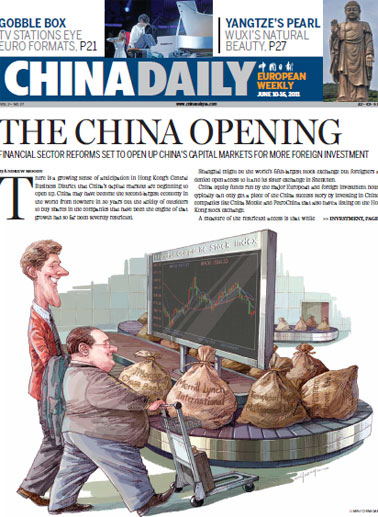Heritage
Seal of approval
Updated: 2011-06-15 08:14
By Zhang Xi (China Daily)
|
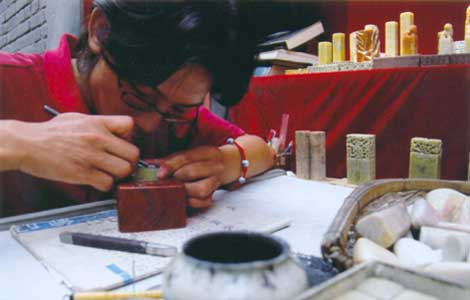 An artisan at a craft shop at Beijing's Liulichang engraves a seal. Li Xiao / China Photo Press |
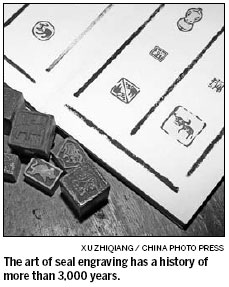
The dying tradition of insignia stamp engraving has become a university major. Zhang Xi reports.
The Beijing Olympic Games was billed as modern China��s coming out party and as billions of people around the world watched on television, a striking and very traditional image of the nation was revealed to all. The Games�� official emblem depicted an ancient seal inscribed with a dancing figure, which was also in the shape of the character jing, which means Beijing. This iconic Chinese image was stamped into the memories of everyone who watched the 2008 Games and was perhaps the biggest ever promotion for seal engraving, an art form that can be traced back 3,000 years.
Throughout history, artisans engraved seals as symbols of state power and personal identification.
Nobles and government officials handed a tally to their trustees in order for them to perform official negotiations. The seal stood for responsibility, obligation, trust and promise, and paved the way for clear communication and vouched for the authenticity of messages. The seal itself was a representative of the sender.
After the 13th century, seal engraving started to become an art form in China and became part of a scholar's standard paraphernalia.
The seals not only included names but also featured poems or phrases that expressed the bearer's individuality. Some seals were engraved with pictures.
The special characters used on the engravings are different from normal characters and evolved from oracle-bone inscriptions. These seal characters appeared in the Zhou Dynasty (c.11th century-256 BC) and the neat structure of oracle-bone inscriptions laid the foundation for modern Chinese characters' forms.
Now, 21st century scholars have taken up the seal-engraving cause.
Last year, China's first seal engraving postgraduate received his degree from the Chinese Academy of Seal Engraving Art, the only Chinese institute that offers the subject as a major and focuses on the tradition's research and preservation. This year, five more postgraduates are taking the course.
In recent years, seal engraving advocates have been busy promoting their trade.
In 2006, the Chinese Academy of Seal Engraving held an exhibition in Torino, Italy, which was the first of its kind in Europe. The institute plans to hold an exhibition in the United States in 2012.
During the 2008 Beijing Olympics and the 2010 Shanghai Expo, seal-engraving experts also seized the chance to show off the tradition. And in 2009, UNESCO added seal engraving to its Intangible Cultural Heritage list.
"Seal engraving has won much attention at home and overseas after the 2008 Beijing Olympics," says Luo Pengpeng, vice-president of the Chinese Academy of Seal Engraving Art and the person who successfully applied to UNESCO for the protection order.
"The success of being listed as a form of intangible culture heritage further enhanced the influence of the art. For example, before the art form was listed, many people thought seals were only used for official documents. But they now know those stamps are different from seal engraving."
Xiling Society of Seal Arts, China's first and largest academic society for seal engraving, with more than 300 members, staged a special show during the Shanghai Expo and many specially made seals were given to visiting foreign leaders.
"The society has already held seal engraving exhibitions in the United States and Europe in the past four years," says Tong Yanfang, deputy director of the Hangzhou-based Xiling Society of Seal Arts. "And we will demonstrate our artwork in London this September."
From an international perspective, seal engraving is still a small-scale art form, which is mostly confined to China, Japan and South Korea. Most of the foreign members of Xiling Society of Seal Arts are Japanese.
"Very few art exchange activities in Western countries are specifically organized for seal engraving," says Cai Shunong, a Xiling Society of Seal Arts member and deputy secretary-general of the Calligraphers Association in East China's Zhejiang province.
"In most cases, seal engravers are just part of a group of artists who go abroad."
Seal engravers must not only master the art of carving but also learn the seal characters.
"Learning seal characters is the first barrier for beginners of seal engraving, and then these characters must be arranged in a good layout to look beautiful. They make seal engraving a difficult art to master," Luo says.
Luo says the government in recent years has been promoting the art form by giving away seals to VIPs. In the past, visiting foreign leaders always received silk or china as presents, but today they are receiving seal engraving gifts.
But presidents and heads of state are not the only foreign visitors to enjoy the art. Seals have also become popular gift for ordinary tourists.
They visit a store and tell their names to the engraver, who thinks of a Chinese translation. About an hour later, a personal seal is finished.
Beijing's Panjiayuan market is a popular antiques and handicrafts center where dozens of seal engravers operate. Prices vary from 50 yuan to 2,000 yuan ($7.70-308), depending on the material used to make the seal.
"Foreign tourists prefer seals with knobs, and the Chinese dragon is their favorite. They often choose those priced between tens and hundreds of yuan. Even UN officials have bought our products as gifts," shop owner Ji Fengguang says.
But the business has not been easy for some shopkeepers.
Lu Pin, a Beijing seal engraver who closed his art shop in Liulichang years ago, says that the government should do more to strengthen the marketing of the art.
Located in downtown Beijing, Liulichang is famous for a series of traditional Chinese stone dwellings where various craftwork and antiques are sold. It is one of Beijing's traditional old quarters.
Lu says stores focusing on selling seals here find it difficult to survive. Engraved seals are always sold with other artworks, such as pieces of calligraphy.
"Very few people use seals in their daily lives except for calligraphers," Lu says.
"For most people, seals are just novelty gifts without any practical value."
Lu says expensive seals made of precious stones and carved by famous artists are usually sold for thousands of yuan, and are not affordable for ordinary people. But cheap varieties are often of poor quality. "The government should take action to ensure the market's stability," Lu says.
"For example, it can establish a special street to sell high quality seals at proper prices."
E-paper

Pearl on the Yangtze
Wuxi is considered a town of natural beauty and its motto is "city of water and warmth".
Prose and consternation
Riding on a mystery train
Way of a warrior
Specials

When two are one
After a separation of 360 years, Huang Gongwang's famous Dwelling in the Fuchun Mountains has been made whole again.
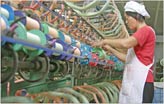
Wealth of difference
Rich coastal areas offer contrasting ways of dealing with country's development
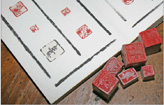
Seal of approval
The dying tradition of seal engraving has now become a UNIVERSITY major
